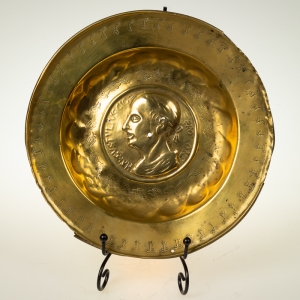Nuremberg bowl - a multifunctional vessel made of brass. Decorated with repoussé friezes showing leaves and flowers. In the center, there is a repoussé profile of a man and an inscription in Latin. The shown figure is Marcus Tullius Cicero, a Roman politician and philosopher. Cicero wrote in his works, often in the same passage, simultaneously about the gods and the Supreme God. In this matter, he shared the attitude of the Stoics who believed that the traditional gods were manifestations of the presence of the One God in the world. Thus, the works of Cicero could be read in the spirit of monotheism, and the Fathers of the Church often referred to him.
# 888888; ">Nuremberg bowls - decorated metal vessels, the main center of their production was located in Nuremberg. In 1493, bowl breakers were given the status of a guild, only Nuremberg townspeople could do it. In 1618, the law was repealed and the craft collapsed. The bowls were widely used. In the houses of the poorer townspeople, they were only decorations, in the richer they were used for washing hands, they were used by barbers during their work. In the 17th century, when they began to go out of fashion, they were eagerly handed over to churches, where they served as sacrificial or baptismal bowls for ashes or earth.
: # 888888; ">Source: B. Bartkowiak, Brass Nuremberg bowls in the collection of the Archdiocese Museum in Poznań, Ecclesia. Studies in the history of Greater Poland, vol. 7, 2012.
/ Nuremberg bowl, renaissance, Germany, 16th century /











